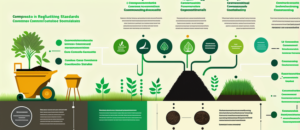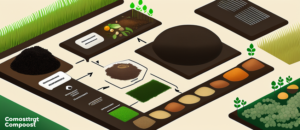Guidelines for Composting: Regulations ensure composting safety and quality. Due to its environmental and economic benefits, composting has become popular. Composting facilities can harm humans and the environment without proper regulations. This blog post will discuss the importance of composting regulatory standards, the role of regulatory bodies in ensuring safety and quality, and a comprehensive overview of composting regulations.
Understanding Compost
Composting is a sustainable way to manage and divert organic waste from landfills. Composting has many benefits. It reduces landfill waste and greenhouse gas emissions from organic waste decomposition. Compost improves soil fertility, water retention, and erosion. Composting also reduces chemical fertilizer use and promotes circular economy.
Composting methods vary by scale and organic waste. Windrow composting, where organic materials are piled in long rows and turned, and in-vessel composting, which uses enclosed containers to control temperature and moisture, are examples. Vermiculture and aerobic static pile composting offer benefits depending on resources and goals.
Regulations Overview Of Composting
Composting regulations protect public health, the environment, and compost quality. These standards govern composting facilities’ design, waste management, product quality, and worker safety. Regulatory standards set expectations for consistent, responsible composting.
Composting regulations have many goals. First and foremost, they limit compost contaminants and pathogens to protect human health and the environment. Regulatory standards also ensure that composting operations are compatible with neighboring communities by minimizing odor and dust. By requiring recordkeeping and reporting, these composting standards promote transparency, accountability, and traceability.
Regulations greatly affect composting. They improve safety, efficiency, and public trust in composting as a sustainable waste management solution. Regulatory standards promote best practices, innovation, and composting industry growth by establishing quality control and environmental protection standards
Regulatory Agencies
Several regulatory agencies develop and enforce composting laws. Internationally, the ISO has composting standards. These standards aid international harmonization.
The EPA, Environment Agency, and AORA regulate composting nationally. These regulatory bodies work with industry stakeholders, scientists, and other organizations to keep regulations current and effective. Harmonization among domestic and international regulatory organizations streamlines compliance and promotes knowledge and best practices.
Composting Facility Safety
Composting facilities must be designed and built safely. Facilities should prevent odors, dust, and other contaminants from escaping and prevent fires. Separate areas for incoming organic waste, active composting, and finished compost must be provided. To prevent runoff and water contamination, composting facilities should have stormwater management systems.
Site selection and zoning regulations help reduce the community impact of composting facilities. Composting operations are zoned to avoid noise, odor, and traffic issues in residential and commercial areas. Site selection should consider proximity to organic waste delivery and compost distribution routes and utilities and infrastructure needed for efficient facility operation.
Safe and efficient composting requires waste handling and management protocols. The proper handling and storage of incoming organic waste prevents cross-contamination and the introduction of prohibited materials. To promote efficient decomposition and reduce odors and pathogens, composting facilities should establish procedures for monitoring and controlling compost pile temperature and moisture levels and for regular turnover and aeration.
Composting Standards
Composting process standards ensure optimal decomposition and high-quality compost. Composting results depend on material selection and preparation. Microbial activity and decomposition require materials with the right carbon-to-nitrogen ratio, moisture content, and particle size distribution. Composting facilities must specify acceptable waste streams and ban hazardous materials when sourcing organic waste.
Composting requires temperature and moisture control. Composters can adjust conditions to optimize microbial activity by monitoring these parameters. Turning and aerating compost piles ensures oxygen and organic matter breakdown. These actions improve decomposition, reduce odor, and prevent anaerobic conditions that may produce harmful byproducts.
Quality Control Testing
Sampling and analysis are used to evaluate compost quality and suitability. Physical, chemical, and biological tests determine compost quality. Texture, moisture, and particle size are physical characteristics. Nutrients, pH, and contaminants are chemical properties. Biological testing measures microbial activity and pathogens.
Compost quality is regulated by contaminant limits and pathogen reduction requirements. These limits prevent heavy metals, synthetic chemicals, and other pollutants from harming humans and the environment. Standards also establish compost maturity and stability criteria to ensure safe handling and phytotoxicity.
Safety Procedures
Composting facilities must prioritize worker safety. PPE protects workers from dust, volatile organic compounds, and airborne microorganisms. Masks, gloves, coveralls, and eyewear are PPE. Workers should be educated about composting risks and trained to mitigate them through occupational safety guidelines and programs.
Hazard communication and emergency response protocols prevent and manage incidents. Composting facilities must communicate hazards, safety procedures, and emergency contacts clearly. Employees should be trained in spill containment, evacuation, and first aid. Drills and exercises boost facility safety and preparedness.
Legal Reporting Of Composting Facilities
Composting facilities must keep detailed records to comply with regulations. These records demonstrate regulatory compliance and may include waste sources, composting processes, quality control tests, maintenance activities, and worker training. Regulatory bodies inspect and audit facilities to ensure compliance and document accuracy.
Composting regulations require regulatory reporting. Composting facilities must submit periodic reports on waste, compost production, and quality control. These reports help regulatory bodies evaluate composting facilities, identify trends, and make informed regulatory changes.
Environmental Concerns
Composting regulations also consider environmental impacts to minimize their impact on local ecosystems. Odor control and air quality standards reduce composting’s impact on neighboring communities. Biofilters or covers may be needed to prevent odorous compounds from escaping composting facilities. Air quality monitoring may be required to meet particulate matter, volatile organic compound, and other air pollution standards.
Responsible composting requires environmental impact assessment and mitigation. Composting operations may affect soil, water, air, and biodiversity. Best management practices like erosion control, stormwater management, and leachate contamination prevention mitigate negative effects. Composting regulations promote sustainable waste management that protects ecosystems and natural resources.
Educational Outreach
Successful composting regulations require community engagement and education. Outreach and awareness campaigns promote composting, dispel myths, and educate the public. These programs encourage composting as a sustainable waste management solution by promoting ownership and understanding.
Public participation in composting regulation development and revision ensures diverse perspectives. Public consultations, stakeholder meetings, and advisory committees can engage stakeholders. Regulators can promote transparency, trust, and informed decisions by involving the community.
Proper composting education ensures that individuals and businesses compost responsibly. Household composting regulations should stress source separation, material selection, and carbon-to-nitrogen ratio. Workshops, online resources, and community and educational partnerships can deliver composting education programs.
Monitoring and Enforcing
To ensure composting facilities follow regulations, monitoring compliance is essential. Monitoring may include routine inspections, compost and site sampling and testing, and record review. Monitoring helps regulatory bodies identify non-compliance, evaluate regulations, and guide enforcement.
Composting violations must be enforced. Warnings, corrective action plans, fines, suspension of permits, and even closure of non-compliant facilities are possible. Regulatory bodies send a clear message that compliance is essential and that violations will not be tolerated by enforcing consequences.
Monitoring and enforcement case studies demonstrate the benefits of regulatory standards. These studies show how diligent monitoring and strong enforcement improved compliance, safety, and environmental protection. Regulatory bodies can encourage composting compliance by sharing success stories.
New trends Of Safety and Implementation And Guidelines for Composting
New composting tecchnologies and methods emerge regularly. These innovations improve composting’s efficiency, effectiveness, and sustainability. These composting innovationsfrom biochar soil amendments to advanced composting systems that optimize temperature and oxygen levelshold promise for the future.
New regulatory methods are being considered to address composting industry issues. As composting processes and risks evolve, regulatory bodies may revise or create new standards to address emerging contaminants or composting methods. Adaptive regulatory frameworks keep composting regulations relevant and adaptable to waste management changes.
Future composting regulations may include circular economy principles and more comprehensive life cycle assessments. Composting regulations may encourage agriculture, horticulture, and local composting infrastructure. To maximize composting’s sustainability, regulations may also consider environmental, social, and economic factors.
Conclusion of Guidelines for Composting
Finally, regulatory standards ensure composting safety, quality, and environmental sustainability. Composting organic waste into nutrient-rich compost has many benefits, from waste diversion to soil improvement. Composting facilities must follow regulations to responsibly use these benefits.
Regulatory standards cover facility design, waste management, compost quality control, and worker safety. Transparency, accountability, and best practices protect public health and the environment. Composting facilities boost public trust, innovation, and sustainability by meeting these standards.
Thus, composting stakeholdersfacility operators, regulators, and the publicmust recognize the importance of regulatory compliance and adopt sustainable composting practices. Thus, we can improve the environment, conserve resources, and promote a circular waste management system.
FAQs About Guidelines for Composting
Q: Is urban composting regulated?
Urban composting has rules. To make composting facilities fit into urban environments, these regulations may address odor, noise, setbacks from residential areas, and traffic management. These regulations are usually set by local governments to reduce community nuisances.
Q: How do regulations protect composters?
A: Occupational safety standards protect composting workers. These standards may include PPE, hazard communication and emergency response training, and composting material safety guidelines. Composting facilities follow these standards to protect workers from accidents and hazards.
Q Can composting facilities irrigate with treated wastewater?
A: Treated wastewater irrigation in composting facilities is regulated. These standards usually address water quality, wastewater treatment, and compost or environment contamination. To protect water resources and compost quality, composting facilities that use treated wastewater for irrigation must follow these standards.
Q: Are compost labels and marketing regulated?
A: Compost labeling and marketing are often regulated. Product labels may need to include nutrient content, compost maturity, and use restrictions. These regulations promote product quality, accurate and transparent consumer information, and the prevention of compost product misrepresentation.
Q: How are composting regulations adapting to microplastics in compost?
A: Composting regulations are constantly changing to address industry issues like microplastics. Microplastics affect compost quality and environmental risks, so regulatory bodies are developing new standards and testing methods. As our understanding of microplastics in compost grows, regulatory standards will likely include specific guidelines for monitoring, reducing, and managing microplastics in composting operations.
Our Reader’s Queries
What are the rules for composting?
Start composting by combining 2-3 parts of “brown material” such as fall leaves, twigs, shredded newspaper, straw, wood chips, and shredded wood with 1 part of “green material” like vegetable and fruit scraps, coffee grounds, crushed eggshells, garden and grass clippings, and tea bags without staples. Keep the mixture moist by adding water. This will help create nutrient-rich compost for your garden.
What are the basic requirements in composting?
To achieve top-notch compost decomposition, there are seven key requirements to keep in mind. These include compost size, air, moisture, fragment size, green matter, dry matter, and heat. By paying attention to these factors, you can produce a bountiful supply of nutrient-rich humus for your organic garden.
What are the do’s and don’ts of composting?
For the ultimate enclosed backyard compost pile, aim for a size between 3′ × 3′ × 3′ to 5′ × 5′ × 5′. Keep in mind that certain items should never be added to your compost pile, such as meat scraps, bones, grease, whole eggs, or dairy products. These items decompose slowly, create unpleasant odors, and can attract unwanted rodents. Additionally, avoid adding pet feces or spent cat litter to your compost pile. Stick to these guidelines for a successful and odor-free composting experience.
What are 3 best practices for composting?
To achieve success in composting, it’s important to chop larger materials before adding them to the mix. Additionally, it’s recommended to mix brown materials with green materials for optimal results. To maintain the right level of moisture, aim for a dampness similar to that of a wrung out sponge. By following these simple tips, you can ensure that your composting efforts are effective and efficient.



